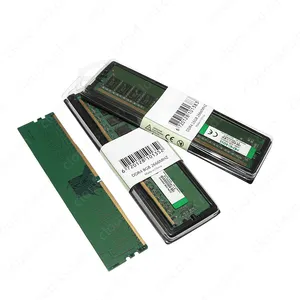
All categories
Featured selections
Trade Assurance
Buyer Central
Help Center
Get the app
Become a supplier

(1110 products available)


































The 1GB DDR RAM comes in different versions. Those versions include DDR1, DDR2, DDR3, and DDR4. Each type has unique qualities that set it apart from the others.
DDR1:
The first version of Double Data Rate (DDR) came out in 2000. Its introduction marked a significant improvement from the existing SDRAM. This intro provided better transfer rates to computers. Although it is the first generation (DDR), it laid the foundation for future DDR RAMs. DDR1 achieved a 200 MT/s transfer rate. It operated at a voltage of 2.5 V. Even though it is an ancient model known to many as the first generation, it is still used in some computers and laptops to date. The availability of DDR1 in the market is limited because suppliers and manufacturers focus on newer generations.
DDR2:
DDR2 hit the market in 2005 after DDR1. It replaced DDR1 and introduced an enhanced version of DDR SDRAM. The chips on DDR2 ran at a lower voltage of 1.8 V compared to DDR1. This meant that DDR2 consumed less power, which meant improved energy efficiency. DDR2 also provided better transfer rates, with an MT/s performance ranging between 400-800. It did this by introducing prefetch technology. It operated on the same bus frequency as DDR1, but the data transfer took twice the amount of time. Manufacturers produced DDR2 in larger capacity modules like 1GB to meet user demand.
DDR3:
DDR3 came to replace DDR2 in 2007. It offered data transfer rates of up to 1600 MT/s. It also introduced a new voltage level of 1.5 V, which helped reduce power consumption. Manufacturers designed DDR3 with an 8n prefetch architecture, which improved data transfer efficiency and speed. The RAM modules also featured a chip stacking technique that increased memory capacity.
DDR4:
DDR4 introduced improvements over the previous versions. Its speed ranged between 1600 to 3200 MT/s. It also operated at a voltage of 1.2 V, thus enhancing energy efficiency. DDR4 used 8n +trish prefetch architecture, which increased memory efficiency and improved data transfer.
Due to the small size of the 1 GB DDR RAM module, it can be frequently used in embedded systems. Here are some features of the 1 GB DDR RAM that manufacturers and businesses often highlight:
1 GB DDR RAM can be useful for many industries. Manufacturers of 1 GB DDR RAM can target the following markets:
Industrial Machines
DDR RAM is common in industrial systems which control and monitor machines and workflows. This RAM can offer reliable performance for tasks like data acquisition, real-time processing, and system control. An example of an industrial system that uses RAM is Programmable Logic Controllers (PLCs). These PLCs and other systems depend on DDR RAM for data storage and program execution.
Embedded Systems
Embedded systems run software designed for a particular task. These systems need RAM to temporarily store data and program code. Anything from smart meters to robots to point-of-sale terminals are embedded systems that depend on DDR RAM.
Consumer Electronics
DDR RAM is found in TVs, game consoles, tablets, and other electronics. These devices need RAM to run applications smoothly. Game consoles, in particular, need reliable DDR RAM to run game graphics and gaming applications without lag.
Computers and Laptops
Manufacturers still use DDR RAM for desktops and laptops. Computer users now upgrade their computers or build them using bundled computer kits. DDR RAM can help users run multiple tabs and programs without computer lag and freezing.
Communication Equipment
modem, routers, and other communication devices rely on DDR RAM for data storage and network packet processing. DDR RAM gives these devices the ability to run smoothly and respond quickly to network demands.
Military and Aerospace Applications
Specialized DDR RAM (e.g. rugged DDR RAM) can work under extreme conditions. Military applications use this RAM for data storage, system control, and signal processing.
Before purchasing a 1GB DDR RAM, buyers should consider its form factor, features, speed, and the type of computer or motherboard.
The first thing buyers should look at is the form factor of the DDR RAM. As mentioned before, DDR RAM comes in different form factors. This includes DIMM, SO-DIMM, and MicroDIMM. To know the right form factor to purchase, buyers should check the current RAM to see its form factor type. Buyers should also consider other devices suchs as laptops and motherboards that are stored in different sockets to determine the right form factor to go for.
Another important factor to consider is the features of the RAM. Here are some common features of RAM buyers should look out for:
Buyers should also consider the speed of the RAM. The clock speed or frequency of the RAM determines how fast the stored data can be transferred. The faster the speed of the DDR RAM, the faster the device will respond to the commands inputted. To know the right speed, buyers should check the current DDR RAM speed to ensure compatibility. Also, buyers should consider the type of computer the RAM will be stored in. Higher speeds are ideal for gaming systems, while average speed is great for basic tasks.
Q1: Is 1 GB RAM enough for Android?
A1: With only one gigabyte of RAM, multitasking and switching between applications may be difficult.
Q2: Can I do without RAM?
A2: Without RAM storage, a computer cannot function. There will be no temporary files to perform short-term tasks like browsing the internet, gaming, or creating documents.
Q3: Can 1 GB RAM run Windows 10?
A3: 1 GB DDR RAM allows a PC to launch and run a basic OS like Windows 10, but performance may not be satisfactory. It might cause delays or problems when using programs or games.
Q4: Is it possible to use RAM from any computer?
A4: Computer RAM cannot be used from any computer. To be compatible, it must match the type and speed of the specific computer.